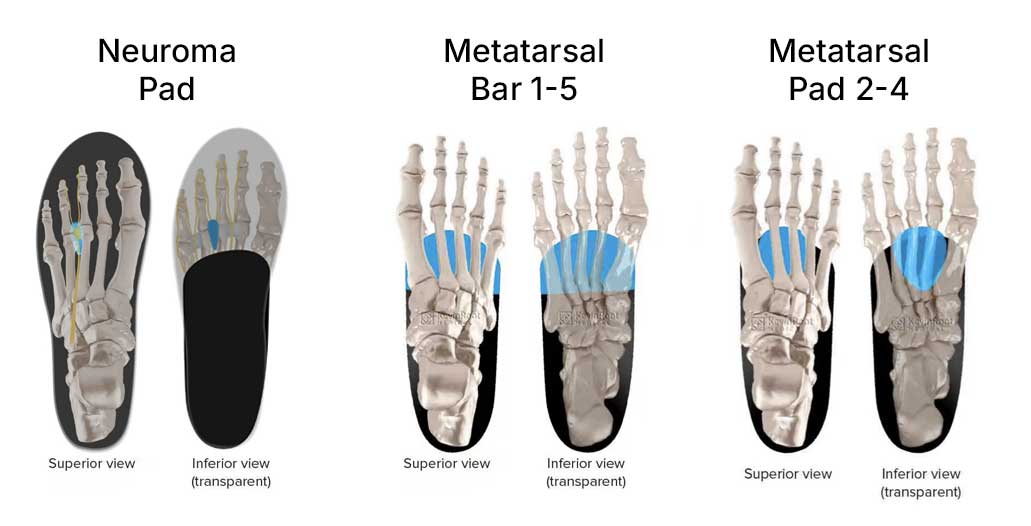In the last post in this series we left off within the “Pads and Cushions” section of the configurator with the met balance pad, the metatarsal punch and the slot accommodation, and the indications for each. Today, we continue in the forefoot extension area of the orthotic device and discuss the 2-4 metatarsal pad, the metatarsal bar, the neuroma pad, the toe crest and the valgus onlay pad. Most of these pads are familiar to lower extremity medical professionals, but others may not be, so hopefully your arsenal of orthotic accommodations will be expanded or refined.

The column labeled “Pads and Cushions” contains a field titled “Metatarsal Pad” which is titled “Metatarsal Pad 2-4” on the KevinRoot Medical website. A metatarsal pad 2-4 is a tear-shaped Myolite padding added to the superior distal surface of the frame. It begins beneath the midshaft of the 3rd metatarsal, expands medially and laterally beneath the 2nd and 4th metatarsal shaft distally and terminates just proximal to the metatarsal heads. The padding is highest in its center and tapered along its edges. It primarily functions to shift metatarsal head pressure to metatarsal shafts, and elevates 2nd, 3rd and 4th metatarsals. It is used for plantar plate pathology, metatarsalgia, forefoot callusing, neuroma, and plantar forefoot bursitis. It is available in thicknesses from 1.5 mm to 6 mm, and can be selected for left/right or bilateral by using the chainlink icon within the field. Placement accuracy for metatarsal pads can be a challenge, if in doubt mark the desired location on your scan, or order the metatarsal pad separate and leave the distal portion of the top cover unglued to allow shifting of the met pad location to the desired spot. Metatarsal pads can also be helpful in preventing forward slippage of the foot upon the orthotic device. Note that this soft metatarsal pad is different from the intrinsic metatarsal pad listed under frame options, which is firm and built into the frame itself.
A metatarsal bar 1-5 is a Myolite padding added to the superior, distal surface of the frame. It covers the distal frame medially to laterally, from the 1st metatarsal base to the distal styloid tuberosity, and extending distally to the edge of the frame. Its proximal, medial and lateral edges are blended into the frame, but the distal edge is left unskived. The purpose is to disperse metatarsal head pressure to metatarsal shafts, and elevate the metatarsals. It is indicated for metatarsalgia, plantar plate pathology, forefoot hyperkeratosis, and forefoot ulcerations. Similar to the metatarsal pad 2-4, it is available from 1.5 mm to 6 mm in thickness, and may be configured for metatarsals 1-4, 1-5, 2-4 and 2-5. You may also differentiate left versus right or bilateral by using the appropriate buttons within the field.
Neuroma pads are narrow teardrop shaped pads intended to be placed in the intermetatarsal space containing a neuroma, and when a patient applies pressure upon it, it lifts and separates the adjacent metatarsals and reduces compression of the neuroma. It is primarily used for Morton’s neuroma of the third intermetatarsal space but may also be also in second interspace pathology.
A toe crest is additional material added to the sulcus area of the forefoot, just proximal to the phalanges, and extends from one side of the extension to the other, medial to distal. It is designed to accommodate hammer toes, claw toes, and similar toe contractures. Note: It is recommended to order a toe crest with a distal orthosis unglued instruction, to ensure correct placement.
A valgus onlay pad is a pad that is applied to the dorsal surface of the frame and increases valgus support in the forefoot. The L shaped pad is thickest at its most anterior, lateral point and tappers out in both a medial and posterior direction. A valgus onlay pad is a valgus wedge and its purpose is to increase pronation forces at the midtarsal joint and the forefoot. It is beneficial in offloading the 5th metatarsal somewhat and therefore useful in tailor bunion deformities and as well lateral instability or hypermobility of the forefoot. Options include metatarsal length on the frame only, or sulcus length distally on the extension.
This concludes our review of the “Pads and Cushions” section of the Foot ID Pro Configurator. Dispersing plantar pressure and accommodating painful lesions and prominences is vital in achieving successful outcomes with custom orthotic therapy. Relief of pain and enhanced mobility of your patients can be extremely gratifying.






